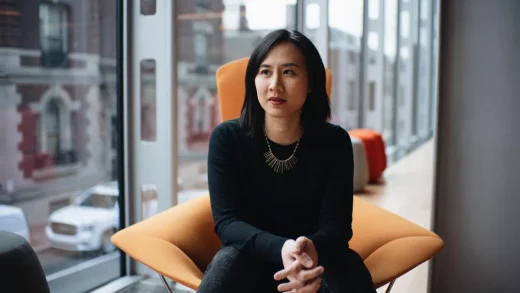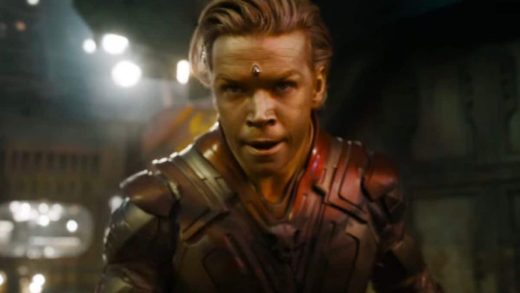:format(webp)/https://www.thestar.com/content/dam/thestar/entertainment/2022/07/30/suddenly-barbie-is-everywhere-and-her-dreamhouse-is-in-mississauga/option_a.jpg)
Contrary to legend, Barbie’s dream house is not in Malibu overlooking the Pacific Ocean. Rather, it is at least for the foreseeable future, located in another waterfront locale known as Mississauga, Ontario, inside an enormous greyish building overlooking the Square One Shopping Centre.
I know this because earlier this month on an oppressively hot July afternoon, I walked through a white archway into the World of Barbie, an immersive experience brought to you by Mattel and American entertainment company Kilburn Live.
The World of Barbie is a life-size version of Barbie’s iconic dream house, surrounded by a 30,000-square-foot Barbie-drenched environment, all scaled to the dimensions of a human being old enough to have a smartphone. Picture Barbie’s camper van, swimming pool, an Astroturf courtyard lined with hot pink street lamps and nearby, a Barbie-themed laboratory, space shuttle, music studio and fashion runway. Each is a nod to Barbie’s 250 careers and counting — and a testament to the miracle that while mortal women can’t and never will have it all, Barbie has it all at once.
This real-world experience is a pivot for a brand that is, however implausibly, already on top of the world. Barbie may have faced ups and downs in the marketplace over the years, but according to American market research company the NPD Group, the iconic doll was the “Global top toy property” in 2021. Now it would seem Mattel’s goal is to transform Barbie from a doll into a bona fide lifestyle.
The company is pursuing a “franchise strategy,” according to Julie Freeland, a senior director at Mattel, that takes the core of the business — toys — into the realm of gaming, apps and location-based entertainment. It currently puts out a drove of content, from the design app Barbie Dreamhouse Adventures to the new Barbie Netflix series “It Takes Two,” in which “fab friends Malibu and Brooklyn” pursue their music dreams in New York City. This month, Warner Brothers wrapped production on the Barbie movie starring Margot Robbie and Ryan Gosling, and directed by indie darling Greta Gerwig. Following its global debut this summer, the World of Barbie exhibit will tour New York City, Chicago, and Dallas among other cities.
“In China we opened a Barbie ice cream shop,” Freeland said sitting in the living room of Barbie’s dreamhouse by the fuchsia glow of a faux fireplace. “This brand does lend itself to different formats.”
“Barbie has been in growth mode for three or four years,” James Zahn, deputy editor of the Toy Book, an American toy-industry trade publication, told me. “The brand has been modernized to better reflect the world around us.”
In 2016, amid financial trouble and cultural backlash against the decades old doll’s notoriously slim figure (a slumber-party Barbie released in the ’60s came with a miniature scale that was set permanently at 110 lbs.), Mattel took a risk and introduced a line of Barbies with more realistic body types: “curvy,” “petite” and “tall.” The gamble paid off. “Barbie being reinvigorated was part of their big turnaround effort and 2021 was the best year earning wise that Mattel has ever had,” said Zahn.
It may also be the brand’s best year from a cultural standpoint too. Barbie, if you hadn’t noticed, is having a moment. This month Mattel announced it will launch a space-themed toy line in partnership with Elon Musk’s rocket company SpaceX. Meanwhile, “Barbiecore” has emerged as a major fashion trend (think short pink hem lines and chunky heels) among a diverse group of celebrities and influencers, from Rihanna to Anne Hathaway. According to Business Insider, “the bimbo aesthetic, an ode to Barbie, is making waves and also highlighting — in a loud colour — how feminism, diversity, and even global politics intersect.”
The World of Barbie is not merely an immersive experience for kids who play with the doll: it is a well-timed social media bonanza for parents who used to play with her, and in some cases those who still do. It’s also likely a play to leverage the sudden obsession with the brand from the fashion and beauty world.
It’s not uncommon for toymakers to target the so-called “kidult” market — that is, adults who buy kids’ toys for personal use. While I didn’t encounter any “kidults” that afternoon, I did find myself in the permanently distracted presence of a pack of influencers.
When I arrived there were about two dozen of them strolling the taffy-pink “streets” of the exhibit (Barbie Boulevard, Ken Lane) assuming the eternal pose of their kind: arms outstretched, phones in hand, thumbs on screen. Most were motherhood and lifestyle bloggers invited to document the birth of Barbie’s World: 30-something year old moms in pastels and hot pinks with kids in tow.
When a toddler in a floral sundress had a meltdown outside Barbie Interstellar Airways, her mother, wearing the identical dress in an adult size, rushed over to console her. In fact, a few mother-preschool daughter pairs wore matching dresses — a social media trend that, unbeknownst to me has been flourishing for several years; my wife informed me it is called “Mini Me.”
I left the space shuttle and lay back in a yellow cabana chair on Barbie’s poolside deck and watched kids ripping down the “water slide” into a pit of luminous plastic. The pool was the place to be. It was filled to the brim with 50,000 translucent plastic balls, an attraction irresistible to kids, influencers and cynical reporters alike.
A worried mom whisked by. “Where’s Kensington?” she asked no one in particular.
I had a question too. Where the heck was Barbie? And who is she?
Today Barbie is on the Supreme Court and in space. But for decades the doll was derided as a bad hangover from the 1950s era in which she debuted, sexist and hypersexualized. The last few chapters in her corporate story have been defined by competition with dolls arguably far raunchier than she is: Bratz and L.O.L. Surprise! from MGA Entertainment. Characterized by oversized heads and eyes, and ensembles best suited for the Vegas strip, their bodily proportions aren’t merely “unrealistic,” they are inhuman. Of course, they sell like mad. In 2017, Forbes declared L.O.L. Surprise! “the top doll with over 2.5 million sold in five months.” Competition between the brands is tight: In 2020, NPD named L.O.L. Surprise! the top-selling toy property in the U.S., while Barbie’s dreamhouse was named the top-selling individual toy.
“Competition is one of the reasons why Barbie is constantly evolving,” said Zahn.
He noted that today Barbie comes in multiple skin tones and hairstyles and with a range of abilities. She has prosthetics and cochlear implants. Last year Mattel designed a Barbie in the likeness of English vaccinologist Sarah Gilbert, the co-creator of the Oxford/AstraZeneca vaccine. (Gilbert herself described the gesture as “strange,” but said she hoped it would inspire young girls to pursue STEM).
It seems the brand has chosen to lean in hard to wholesome feminist themes, despite the fact that its competitor appears to have done the opposite.
This presents a more immediate challenge in Barbie’s World: if Barbie is a vaccinologist and a Malibu mall rat, which Barbie exactly lives in the dreamhouse? Investigating this question, I riffled through Barbie’s home office, peeked inside her fridge (mostly fruits and veggies) and attempted to pry open her freezer (it was locked.) I wandered around her sprawling walk-in closet and counted her shoes — all 14 pairs. I covered my ears outside her music studio where kids banged on the beat pads of a DJ console with wild abandon. I stood inside her empty laboratory and gazed into a hot pink microscope at a picture of pollen. I saw her TV studio where a breaking-news story about the birth of a baby elephant ran across a flat-screen TV.
I didn’t see Barbie. In fact Barbie was most evident by her absence. It was a vaguely eerie feeling, as though Barbie had gone to Europe, possibly, and I was breaking into her house.
This isn’t so at other kids’ entertainment spectacles. At Disney World you can’t escape the life-sized versions of Mickey and Minnie. At the Dr. Seuss Experience (a Kilburn Live production that ran in the same Mississauga space a few years ago), guests beheld an animatronic Cat in the Hat. But not only were there no character actors portraying Barbie and Ken at World of Barbie, even the life-sized astronaut hanging on the wall in Barbie’s space shuttle was faceless. It could have been anybody underneath that helmet.
Which turns out to be exactly the point. It was a conscious decision on the part of production not to have an official Barbie and Ken roaming the exhibit. “This is about ‘you can be anything,’ and Barbie is inspiring the limitless potential in every girl,” Jonathan Sanford, COO of Kilburn Live told me. “When you’re coming here, you’re supposed to be going ‘I can be an astronaut.’”
Sanford later echoed the sentiment when he came over to correct the record after I interviewed an attractive blond Caucasian couple wandering about the space. I naturally assumed they were hired to appear as Barbie and Ken; they weren’t.
Barbie’s corporate owners, Sanford said, had hired the couple — American actors Pierson Fodé and Saxon Sharbino — to attend the event, but as social media influencers. They weren’t told to dress up as Barbie and Ken. “We weren’t told we were Barbie and Ken,” Fodé confirmed. “But in our hearts we are Barbie and Ken. Everybody is Barbie and Ken here.”
Walking through the Barbie Museum a few minutes later, past a glass case housing doll versions of Eleanor Roosevelt and Laverne Cox, it occurred to me that the World of Barbie is walking a tricky line similar to the one religious leaders walk when they want to modernize tradition but maintain its essence. It was as if every trace in the place of the superficial Barbie that is canon — white, blond and thin — had an asterisk attached to it that said: “You can be anything.”
“The Barbie of 2022 is not the Barbie of five years ago,” said Zahn. He might have added that the Barbie of five years ago is not even the Barbie of five years ago. The seminal irony about classic Barbie’s Aryan aesthetic is that the doll’s creator, Ruth Handler, was not only the child of Jewish immigrants; she named Barbie after her own dark-haired Jewish daughter.
When I was a little girl, my favourite Barbie happened to be Ken. More accurately he was a facsimile of a Ken doll meant to resemble St. Louis Blues star forward Brett Hull. So the World of Barbie wasn’t a nostalgic adventure for me. But if it’s still around in 20 years, it may be one for my daughter. She’s only two but so far her favourite colour is pink and she loves to twirl around the house in fancy dresses and wear them to the playground.
As a journalist it’s easy to be cynical about the fact that the corporation that gave us the catch phrase “Math class is tough” now churns out feminist mantras with its dolls. As a mother, it’s not. For whatever reason, the Barbie of this era is constantly reminding little girls that high femininity does not preclude high intelligence. In a society that still tells them the opposite is true, it’s hard to find fault with that mission.
JOIN THE CONVERSATION
:format(webp)/https://www.thestar.com/content/dam/thestar/life/together/2022/07/30/suddenly-barbie-is-everywhere-and-her-dreamhouse-is-in-mississauga/option_b.jpg)
:format(webp)/https://www.thestar.com/content/dam/thestar/life/together/2022/07/30/suddenly-barbie-is-everywhere-and-her-dreamhouse-is-in-mississauga/option_c.jpg)
:format(webp)/https://www.thestar.com/content/dam/thestar/life/together/2022/07/30/suddenly-barbie-is-everywhere-and-her-dreamhouse-is-in-mississauga/option_d.jpg)
:format(webp)/https://www.thestar.com/content/dam/thestar/life/together/2022/07/30/suddenly-barbie-is-everywhere-and-her-dreamhouse-is-in-mississauga/ptw_barbieimmersive_01.jpg)
:format(webp)/https://www.thestar.com/content/dam/thestar/life/together/2022/07/30/suddenly-barbie-is-everywhere-and-her-dreamhouse-is-in-mississauga/ptw_barbieopeningday_07.jpg)



